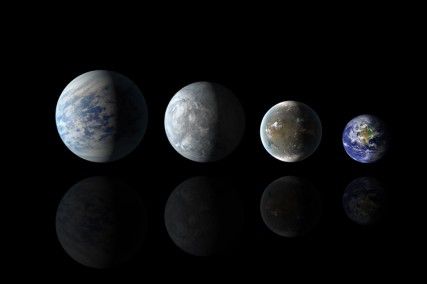
The Kepler mission–which was launched in 2009–has discovered a system of planets, three of which may be life-sustaining. Researchers involved in the mission now believe there are many more habitable planets in space, some of which may support other life forms.
If the film “Star Wars” taught the world anything, it was that getting along with alien life forms might be difficult. However, that has not stopped the National Aeronautics and Space Administration and other scientists from searching the universe for life-sustaining planets — much like Earth — for the past several decades.
While it is unlikely that scientists will find other cognizant life forms on other planets in our lifetime — or in a lifetime where “Star Wars” references will be relevant — they continue to search.
In 2009, NASA launched the Kepler mission in an attempt “to determine how common or rare planets like our own are in the galaxy,” said NASA scientist Thomas Barclay.
He said Earth-like planets are defined as having similar temperatures to Earth and orbit around a star similar to the sun.
On April 18 — more than three years after the mission’s launch — NASA announced that Kepler detected three Earth-sized planets within the habitable zone, a region around a star that is potentially life-sustaining.
While these planets are thousands of light-years away, researchers said the discovery gives scientists hope that more Earth-sized planets may soon be discovered closer to Earth.
The planets
Barclay said the new planets discovered by NASA are classified as “super Earth-sized,” meaning they are 1.5 to 1.75 times larger than Earth. Kepler spotted these new planets — aptly named Kepler-69c, Kepler-62f and Kepler-62e — within the Cygnus and Lyra constellations.
The Cygnus constellation is an about 2,700 light-years away from Earth, which makes exploration of it impossible with current technologies, according to an article on NASA.
The Lyra constellation is significantly closer to us at only 1,200 light-years away. However, this is also too far to explore with modern technologies.
“One of the exciting things that’s come from the Kepler is that it looks like there are planets everywhere and Earth-like planets might be common,” Barclay said. “This means that we can look at nearby stars, much brighter and much easier to follow up using ground-based telescopes.”
Eric Agol, a University of Washington astronomer who was involved in the Kepler mission, said these ground-based telescopes have a much greater range of view.
“The Kepler spacecraft that we’re using now only stares at 1/400 of the entire sky,” Agol said. “So that means for every star it looks at there may be 399 other stars that it can’t look at.”
In order to classify a planet as Earth-like, Barclay said the entity must meet certain qualifications. It must have a rocky surface with the potential of water at its surface and orbit a star similar to the sun. He said these new planets circle stars slightly smaller than the sun, but do so faster and closer.
Kepler-69c has an orbit of 242 days and while its composition is unknown, a NASA press release said it appears similar to Venus.
While Kepler-62e has an orbit of only 122 days and Kepler-62f a period of 267 days, scientists still characterize these super Earth-sized planets as possibly life sustaining.
Detecting Planets
Kepler recognizes planets by the way they affect the light emitted by the star they orbit.
“What Kepler does is it takes a picture of 150,000 stars every six seconds. Literally it does what a digital camera does,” Agol said.
He said it does this by capturing the number of photons that hit the camera every six seconds. These photographs are then combined every 30 minutes or so and sent down to Earth about once a month.
Scientists then analyze the light content produced from the star and note when there is a dip in brightness, suggesting the existence of a planet. They are then able to determine the planet’s orbital length, distance from its star and size all from a picture of light. However, this is not a rapid process.
Agol, the scientist who discovered Kepler-62f, discussed how he recognized a dip in the star’s brightness and then noticed the same dip 267.3 days later.
“Then another 267.3 days [later] there was a third dip in the star’s brightness, and so that indicates that it’s a planet orbiting the star every 267.3 days,” Agol said.
This means that Agol spent over two years watching one star in search of a single planet.
Scientists can also differentiate between separate planets located within the same system. Different planets orbit at different times, but before researchers know which planet is which, this can be confusing. However, scientists can read the light coming from each star and determine if the dip in its light is coming from the same planet.
“Kepler-62e orbits the star every 122 days and so it has a different size,” Agol said. “It causes a different depth of transit so there’s slightly more light that the 62e planet blocks than the 62f planet, which is slightly smaller.”
The implications
Barclay said this discovery and verification of new potentially life-sustaining planets has created an increased appetite among scientists in the pursuit of extraterrestrial life.
“The ultimate question [is] ‘how common are places like our own?’” he said. “Are we alone in the universe? One of the first steps to answering that question is to say, ‘are there places where life could exist?’”
Barclay said the discovery of these new planets is a huge step toward answering that question. For centuries people have wondered if humans are the only cognizant life forms in the universe.
“The idea of there being other life there is quite a big possibility, so I say go for it,” said College of Arts and Sciences freshman Garrett Knauss. “I feel like it’s our responsibility as humans to see what is out there. I think it would bring us together as humans, define us more.”
Moving forward
“Going to these exoplanets is not likely to happen in my lifetime or my great-grandchildren’s lifetime,” Barclay said.
But he said this does not hinder scientists’ enthusiasm in the project.
Both Agol and Barclay said they are looking forward to the upcoming launch of NASA’s new satellite TESS. TESS — which stands for Transiting Exoplanet Survey Satellite — will be able to survey much more of the sky, unlike Kepler.
Finding Kepler-62e, -62f, and -69c has also given NASA scientists more hope for the future of astronomy studies. Now that scientists have evidence that Earth-like planets occur more frequently than previously thought, ground telescopes can also be used to search the sky.
“Seeing as we now have almost four years of data from the Kepler spacecraft, we should see more and more of these habitable zone planets popping up,” said CAS freshman and astronomy major Vishal Bala. “Personally, I’m really excited for that.”
Barclay said ground telescopes are able to survey much more of the universe than Kepler does. They also allow scientists to focus on nearer, brighter stars.
This is beneficial to exoplanet science because, as Barclay said, “we’re not going to be able to go to any planets outside of our own solar system in the near future.”
Barclay said future missions will also focus more on the atmospheres of discovered planets.
“In the next decade or two we’ll be able to say whether small rocky planets have oxygen in the atmosphere, have nitrogen, or have carbon dioxide potentially,” Barclay said.
By focusing on atmospheric composition, he said scientists will be able to determine if there is a bio-signature — or a sign of life — on these planets.
“Discoveries like these are always exciting, and the idea that another planet like Earth may be out there will hopefully increase people’s interest in astronomy and the space program,” said Steve Trudel, a freshman in CAS.
Barclay and Agol said they will continue to search for habitable planets in the coming years, possibly bringing humanity one step closer to discovering other life forms outside of Earth.
CORRECTION: The original version of this story said the planets were discovered in the Lyra and Cygnus ‘galaxies’ when, in fact, Lyra and Cygnus are constellations. The article has been updated to reflect these changes.


























































































































dr blubbenhimer • Apr 30, 2013 at 2:15 pm
wrong wrong wrong wrong and wrong again this page should be thrown in the trash
dr blubbenhimer • Apr 30, 2013 at 1:43 pm
all of this is wrong there werent any planets discovered at all
Alan • Apr 29, 2013 at 8:28 pm
A correction is needed. Cygnus and Lyra are constellations, not galaxies. The candidate planets are located in the area of the sky where those constellations are located.